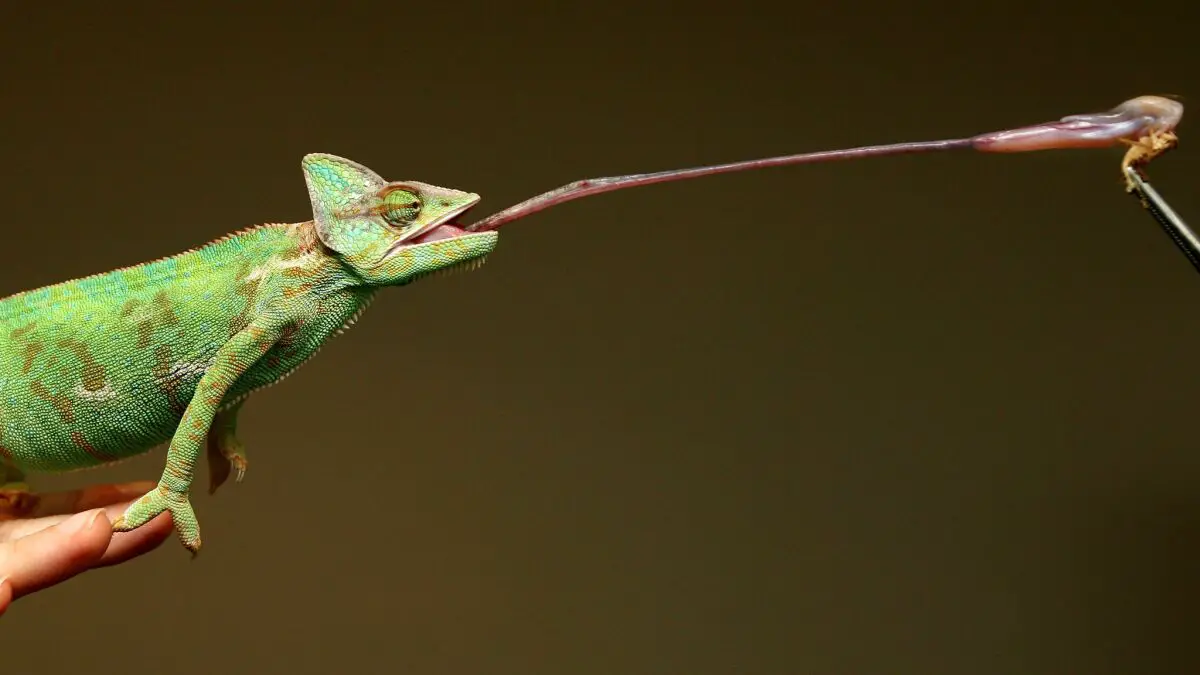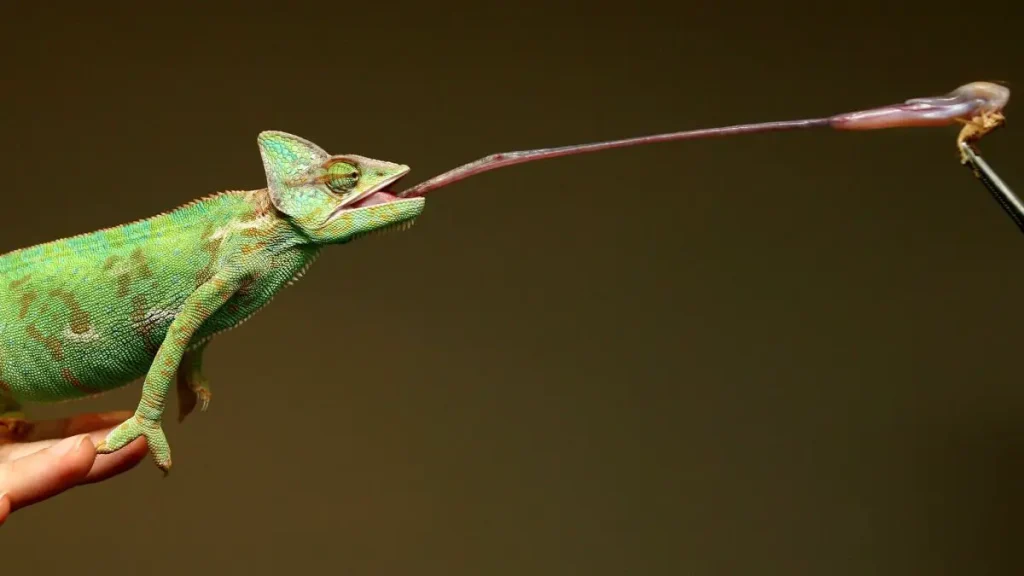Chameleons are intriguing creatures that are known for their ability to change color. But did you know that they also have a unique way of catching their food? Unlike other animals, chameleons have a special hunting technique that makes them stand out from the rest.
When it comes to catching their prey, chameleons use their sticky, extendable tongues to snatch their food in a matter of seconds. But that’s not all – their eyes also play a crucial role in their hunting process. In this article, we’ll dive deeper into how chameleons catch their food and explore the fascinating world of these reptiles.

How Do Chameleons Catch Their Food?
Chameleons are fascinating creatures that have unique adaptations to help them survive in their environment. One of their most impressive abilities is their ability to catch prey. Here, we will explore the different methods chameleons use to catch their food.
Projectile Tongue
The most famous method chameleons use to catch their prey is their projectile tongue. Chameleons have a long, muscular tongue that they can shoot out at lightning speed to capture their prey. The tongue is covered in a sticky substance that helps the chameleon hold onto its prey once it is caught.
The tongue is launched from the chameleon’s mouth by a specialized muscle and bone structure. The tongue can reach a length of up to twice the chameleon’s body length, making it an incredibly effective tool for catching prey. Chameleons use their projectile tongue to catch a variety of insects, including crickets, grasshoppers, and flies.
Slow-Motion Grab
While the projectile tongue is the most famous method chameleons use to catch their food, it is not the only method. Chameleons can also use their slow-motion grab to catch prey. This method involves the chameleon slowly reaching out and grabbing its prey with its hand-like feet.
Chameleons have zygodactyl feet, which means that their toes are arranged in opposing pairs. This arrangement allows them to grasp onto branches and other surfaces securely, making them excellent climbers. Chameleons can use their zygodactyl feet to grab onto their prey and bring it to their mouth for consumption.
Stealth
Another method chameleons use to catch their prey is stealth. Chameleons are masters of camouflage and can blend into their surroundings to avoid detection. They use this ability to get close to their prey without being noticed and then strike quickly when the time is right.
Chameleons will often sit and wait for their prey to come to them, using their camouflage to remain hidden. Once the prey is close enough, the chameleon will make a quick movement to capture it.
Vs Projectile Tongue vs Slow-Motion Grab
While both the projectile tongue and slow-motion grab are effective methods for catching prey, they have different advantages and disadvantages. The projectile tongue is incredibly fast and can catch prey from a distance, making it useful for catching fast-moving insects. However, it requires a lot of energy to use and can only be used once before needing to be retracted.
The slow-motion grab, on the other hand, is less energy-intensive and can be used repeatedly. It is also useful for catching prey that is hiding or moving slowly. However, it requires the chameleon to get closer to its prey, making it riskier.
Benefits of Chameleon’s Food Catching Methods
Chameleons’ unique food-catching methods provide them with several benefits. The projectile tongue allows them to catch prey from a distance, reducing the risk of injury from struggling prey. The slow-motion grab allows them to catch a wider variety of prey and conserve energy. The ability to blend into their surroundings and use stealth allows them to avoid detection and remain safe from predators.
In conclusion, chameleons have evolved several unique methods for catching their food, including the famous projectile tongue, slow-motion grab, and stealth. Each method has its advantages and disadvantages, but together they provide chameleons with the tools they need to survive in their environment.
Frequently Asked Questions
Chameleons are fascinating creatures with unique abilities. One of their most impressive skills is their ability to catch their food. Here are some commonly asked questions about how chameleons catch their food.
How Do Chameleons Catch Their Food?
Chameleons are carnivorous animals, which means that they eat other animals. To catch their food, chameleons use their long, sticky tongues. The chameleon’s tongue can be up to twice the length of its body and can shoot out at a speed of up to 26 body lengths per second. When the tongue hits its prey, it sticks to it, and the chameleon reels it back into its mouth.
Chameleons are excellent hunters and have a 90% success rate when catching their prey. They can catch a variety of insects, including crickets, grasshoppers, and flies. Chameleons are also known to catch small lizards and even birds.
How Accurate Are Chameleons When Catching Their Food?
Chameleons are incredibly accurate when catching their food. Their eyes can move independently of each other, allowing them to focus on two different objects at the same time. This ability gives them excellent depth perception, which helps them accurately judge the distance to their prey.
In addition to their eyes, chameleons have a special organ called the “pectoral girdle” that helps them aim their tongue. The pectoral girdle is a flexible structure that connects the chameleon’s tongue to its skull. When the chameleon shoots out its tongue, the pectoral girdle moves with it, allowing the chameleon to aim its tongue with incredible precision.
Do Chameleons Only Eat Insects?
While insects make up most of a chameleon’s diet, some species of chameleons will also eat small lizards and birds. However, most chameleons are too small to eat anything larger than an insect. Some larger species of chameleons, like the Parson’s chameleon, can eat small birds and rodents.
Chameleons are opportunistic hunters, which means that they will eat whatever prey is available to them. They are also known to eat vegetation, although this makes up a very small part of their diet.
How Often Do Chameleons Need to Eat?
Chameleons have a slow metabolism, which means that they do not need to eat as often as other animals. Most species of chameleons only need to eat every few days. However, this can vary depending on the size and species of the chameleon.
Young chameleons will need to eat more often than adults because they are still growing. Some species of chameleons, like the veiled chameleon, can go for several weeks without eating, although this is not recommended for their overall health.
What Happens If a Chameleon Misses Its Prey?
Chameleons are excellent hunters, but they do occasionally miss their prey. When this happens, the chameleon will retract its tongue and wait for another opportunity to catch its prey. Chameleons have very fast reflexes and can shoot out their tongues multiple times in a matter of seconds.
If a chameleon misses its prey multiple times, it may become frustrated and give up. This is why it is essential to provide chameleons with plenty of opportunities to catch their food, whether it be through live insects or other forms of enrichment.
Tiny Chameleons’ Tongues Pack Strongest Punch (High-Speed Footage) | National Geographic
In conclusion, chameleons are fascinating creatures with unique abilities to camouflage and catch their prey. They have long, sticky tongues that they use to capture insects and other small animals. Their eyes can move independently, allowing them to scan their surroundings for potential prey. Additionally, their color-changing abilities allow them to blend in with their environment, making them excellent hunters.
Overall, chameleons are fascinating creatures with a wide range of interesting behaviors and adaptations. Whether they are blending in with their surroundings or using their long tongues to catch their food, they are truly remarkable animals. So next time you see a chameleon, take a moment to appreciate the amazing skills that make them such successful hunters.


